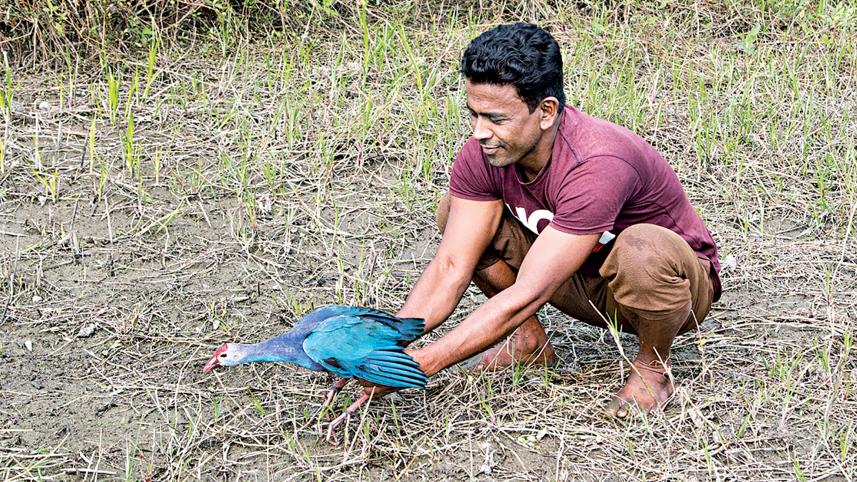Saving the Kalem

It happened just after we emerged from the bushes to face a small crescent-shaped lagoon. A thin layer of winter fog covered the shallow water. Grass and bushes grew around the rim. Perhaps fifty Purple Swamphens (Kalem) - gorgeous birds that were venerated by ancient Romans - played in the lagoon and its banks. They probed the mud and grass for food and sometimes sparred with each other, often flying short distances to claim empty patches.
Our guide Belal was scanning the site. Suddenly he became agitated. “Oh no, that one is trapped!” He pointed to an area about fifty feet to our right at the far edge of the lagoon where a Kalem was hopping from one branch to another. Looking carefully, we realized its feet were caught in a twine that tethered it like a leash as it tried mightily to fly away.
Belal immediately ran to the bird. He caught its wings and, grabbing its feet, gently untangled them from the twine. He brought the bird to us before releasing it.
As he walked back to us, I looked at the glorious expanse of water that lay beyond the lagoon. Tanguar Haor, a Ramsar wetland of global importance, is located in Sunamganj. It encompasses almost 100 square kilometres. (A Haor is a saucer-shaped depression in the land that fills up in monsoon and partially empties in winter.) A place of breathtaking natural beauty year-round, it is a magnet for birders because of the thousands of migratory birds - mostly ducks - that descend here in winter.
Our group of four had arrived here two days earlier from Sylhet. First a microbus had brought us to Sulemanpur, where we had boarded the basic but functional houseboat Rupaboi, our home for the next two nights. After an hour’s cruising, it had anchored at Golapara village inside the Haor.
Using the Rupaboi as base, we were exploring the Haor – which comprises of numerous smaller Beels or lakes – using smaller row boats. Waves upon waves of ducks and water birds cavorted in the waters of Tanguar. We found the most birds in Laichamara Beel, but the Haor also had strips of higher land with vegetation, and the canals running between them offered a chance to see birds closer.
That morning, rowing down one of these canals, we had come ashore for a look and walked across the strip to the lagoon when we discovered the trapped Kalem.
After Belal had brought the Kalem to us, he gently held it, firmly grasping its feet. Every few seconds it flapped its iridescent blue wings, trying to escape. I got a close look at its impossibly long thin toes which enable it to walk on water by tiptoeing across large leaves of Water Lily or Lotus.
Next I examined the trap. An innocuous looking jumble of twine, Belal explained it was hand-crafted and designed to entrap those long-toed feet. The chicken-sized bird was probably trapped by local villagers for their own consumption.
Belal set the bird free and it immediately flew into a dense part of the bush, disappearing instantly. Next he collected some dry twigs, built a small tepee, started a fire and set the trap aflame. We ended our morning adventure by watching it reduce to ashes.
(Tanguar Haor is out of the way but worth the effort. For information on the houseboat see www.facebook.com/Rupaboi).
facebook.com/ikabirphotographs or follow ihtishamkabir on Instagram



 For all latest news, follow The Daily Star's Google News channel.
For all latest news, follow The Daily Star's Google News channel.
Comments